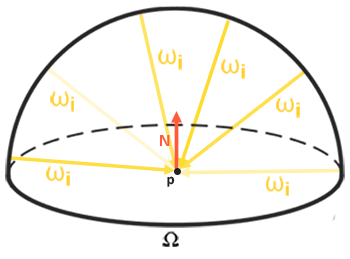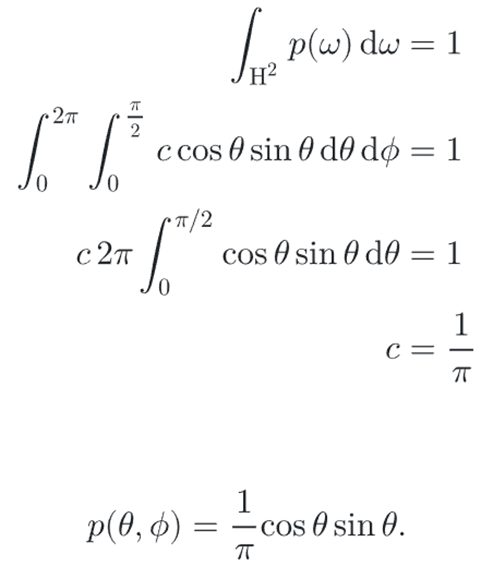【Computer Graphics】基础光线追踪中的采样
本文未经允许禁止转载
B站:https://space.bilibili.com/455965619
作者:Heskey0
因为Graphics领域书籍和资料以英文为主,故本文将以英文的方式呈现。
path tracer based on 《PBRT》

一.introduction to sampling theory
1. what is sampling?
impulse train:

sampling process corresponds to multiplying the function by a “impulse train” function, an infinite sum of equally spaced delta functions.


《PBRT》A digital image is represented as a set of pixel values, typically aligned on a rectangular grid. When a digital image is displayed on a physical device, these values are used to determine the spectral power emitted by pixels on the display.
《PBRT》the pixels that constitute an image are point samples of the image function at discrete points on the image plane.
there is no “area” associated with a pixel.
when sampling the film signal
pos = camera_pos
ray_dir = ti.Vector([
(2 * fov * (u) / resolution[1] - fov * resolution[0] / resolution[1] - 1e-5),
2 * fov * (v) / resolution[1] - fov - 1e-5, -1.0
]).normalized()

then we need anti-aliazing
pos = camera_pos
ray_dir = ti.Vector([
(2 * fov * (u + ti.random()) / resolution[1] - fov * resolution[0] / resolution[1] - 1e-5),
2 * fov * (v + ti.random()) / resolution[1] - fov - 1e-5, -1.0
]).normalized()

二.sampling
Preview (CDF sampling technique)
There are many techniques for generating random variates from a specified probability distribution such as the normal, exponential, or gamma distribution. However, one technique stands out because of its generality and simplicity: the inverse CDF sampling technique.

1. Uniformly Sampling a Hemisphere (multidimensional sampling technique)

a uniform distribution means that the density function is a constant, so we know that p(x) = c

so p(ω) = 1/2*pi
then p(θ, φ) = sinθ/2*pi


Notice that the density function for φ itself is uniform
then use the 1D inversion technique to sample each of these PDFs in turn



2. sample area light

def sample_area_light(hit_pos, pos_normal):
# sampling inside the light area
x = ti.random() * light_x_range + light_x_min_pos
z = ti.random() * light_z_range + light_z_min_pos
on_light_pos = ti.Vector([x, light_y_pos, z])
return (on_light_pos - hit_pos).normalized()

3. introduction to importance sampling
why we need importance sampling?
the Monte Carlo estimator converges more quickly if the samples are taken from a distribution p(x) that is similar to the function f(x) in the integrand.

《PBRT》:We will not provide a rigorous proof of this fact but will instead present an informal and intuitive argument.
then we try to analyze the importance sampling method

we have three terms
- BRDF
- incident radiance ( infeasible )
- cosine term
4. cosine-weighted sampling



Malley's method
So, We could compute the marginal and conditional densities as before, but instead we can use a technique known as Malley’s method to generate these cosine-weighted points.

cosine term
2D Sampling with Multidimensional Transformations
(1) sampling a unit disk (Concentric Mapping)
(2) project up to the unit hemisphere (cosine-weighted hemisphere sampling)
(1) sampling a unit disk


(2) projection
To complete the (r,φ)=(sinθ,φ)⇒(θ,φ) transformation, we need the determinant of the Jacobian

Why

5. multiple importance sampling
BDPT only:

BDPT + MIS:

Why we need MIS?





- balance heuristic
- power heuristic (Veach determined empirically that β=2 is a good value.)
本文未经允许禁止转载
B站:https://space.bilibili.com/455965619
作者:Heskey0







【推荐】国内首个AI IDE,深度理解中文开发场景,立即下载体验Trae
【推荐】编程新体验,更懂你的AI,立即体验豆包MarsCode编程助手
【推荐】抖音旗下AI助手豆包,你的智能百科全书,全免费不限次数
【推荐】轻量又高性能的 SSH 工具 IShell:AI 加持,快人一步
· SQL Server 2025 AI相关能力初探
· Linux系列:如何用 C#调用 C方法造成内存泄露
· AI与.NET技术实操系列(二):开始使用ML.NET
· 记一次.NET内存居高不下排查解决与启示
· 探究高空视频全景AR技术的实现原理
· 阿里最新开源QwQ-32B,效果媲美deepseek-r1满血版,部署成本又又又降低了!
· SQL Server 2025 AI相关能力初探
· AI编程工具终极对决:字节Trae VS Cursor,谁才是开发者新宠?
· 开源Multi-agent AI智能体框架aevatar.ai,欢迎大家贡献代码
· Manus重磅发布:全球首款通用AI代理技术深度解析与实战指南